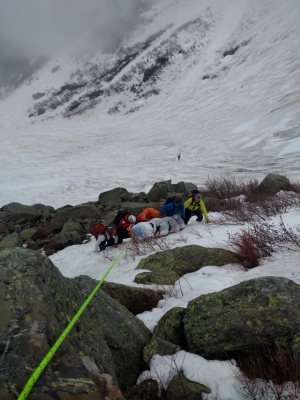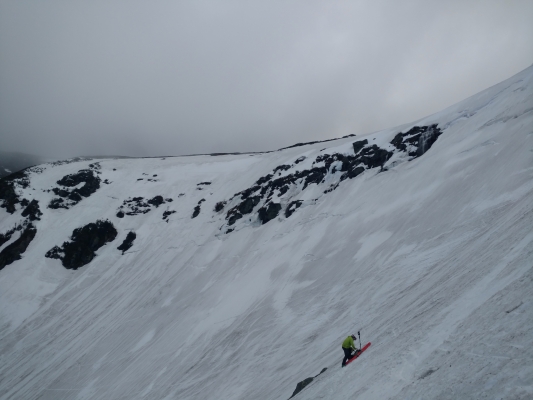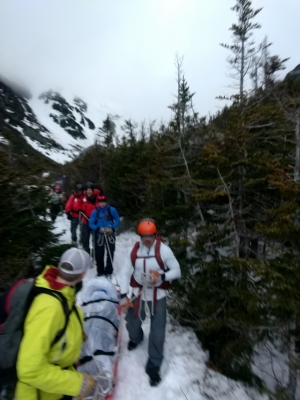Events:
On Saturday May 4, 2019 at approximately 4:00pm, a 66 year old male caught an edge while skiing and took what was described as a “slow speed slide” into a rock below Right Gully. The two other members of his party and some passersby dug a shelf in the snow, assessed his injuries, attempted to insulate him and summoned help via 911. Simultaneously, witnesses to the fall reported the incident to Mount Washington Volunteer ski patrollers in the courtyard at Hermit Lake. A hasty team team consisting of one snow ranger and one AMC caretaker arrived at the scene, where they reassessed the patient and determined that a litter evacuation was required due to the pain level of the patient. A backup team of patrollers and the second caretaker continued up with a technical litter from nearby Connection rescue cache (at the entrance to the floor of the Ravine). The patient was loaded into the litter and wrapped in sleeping bags, blankets and plastic, but had been laying on the snow wrapped in a survival blanket and extra clothes with minimal padding beneath him for an hour or more. Clinical signs of hypothermia began to present themselves and rewarming, even in the relatively warm temperatures was slow. A bystander was posted as lookout to watch for icefall from the frozen waterfalls uphill on the cliff next to Sluice.

Due to other challenges, the traverse beneath the threat of falling ice from Sluice was chosen. Speed often equals safety by reducing the length of time you are exposed to an uncertain hazard.
Due to the slope angle of around 35 degrees and consequences of loss of control, the litter was rigged for a 3rd class lower. The jumble of boulders in the fall line below the patient presented litter movement challenges due to poor footing and fall hazards to the litter carry team and the option to traverse back towards Lobster Claw passed through thick krumholtz and deeply undermined snow. The decision was made to do a downwards traverse towards the Lip and under Sluice ice, the rationale being that the increased exposure to icefall would be brief and the reduction of the exposure to hazards in the boulder field the safest solution.

Another skier, apparently unconcerned about his exposure to the threat of falling ice from Sluice, with a view of ground and sky conditions. It is arguable that the patient warranted a helicopter evacuation. Field assessment of the patient and limited vertical visibility made this option not worth the risk.

The trip to Hermit Lake from the Bowl is rough and takes quite a while.
After the difficult traverse through boulders, and over undermined snow and some ice, a second 60 meter lower using another boulder as an anchor brought the litter to lower angled terrain at the base of the Lip. Here the bystanders rejoined the patrollers and slid the litter through rocks and snow on the Tuckerman Ravine Trail to Hermit Lake, with two more roped lowers through steep sections of the trail. At Hermit Lake, the patient was transferred to a non-technical, Thompson litter and the care of the W-EMT and a Hermit Lake caretaker, and slid to Pinkham Notch, again with the help of bystanders and the patient’s two companions. Care was transferred to an ambulance crew at approximately 9:30 pm.
Analysis:
The patient’s party was a group of typically equipped ski tourers with lightweight equipment and clothing suited to conditions, though, like many visitors to the apparent “slackcountry” which is Tuckerman Ravine, carried no pads, or lengths of rope or tarps for rescue sled or shelter construction. This trip was the patient’s first trip to Tuckerman Ravine and he admitted earlier that it may be “too much” for him. Tracks in the snow and eyewitness accounts indicate that he caught an outside edge during a turn and slid headfirst approximately forty feet into a boulder poking out of the snow. Obstacles like these rocks exist early and late season in most mountain ranges and raise the stakes of any fall or avalanche. While Right Gully is a good option for for first timers or less aggressive skiers, the threat of undermined snow and emerging rocks should factor into anyone’s risk analysis. The concentrated crowds in Left Gully that afternoon tipped the parties’ choice in favor of Right Gully.
Another factor to be considered for anyone skiing in the backcountry is the ability of the party to self-rescue. This team carried an emergency transponder and had cell phone reception in this location. If not for the proximity of helpful bystanders, one of whom was a trained W-EMT, this incident could have taken much, much longer and in the absence of padding to get the patient out of the snow and improvise a shelter, hypothermia would have become a significant problem. A piece of insulating pad, either dedicated or integrated as a lumbar pad in your pack, works much better to insulate a patient from rapid conductive heat loss to the ground or snow. Using spare layers to perform this task leaves everyone else without warm layers and compresses to the point of being almost useless if made of lightweight or synthetic down. As it was, even with help nearby, it was over an hour until the patient was well-protected from the elements and 4 more hours until he was transferred to the ambulance. On days with inclement weather, patrollers or snow rangers may not be nearby, and caretakers could be off the mountain. Rescue caches may be restocked for your use. But maybe not, depending on recent incidents.
It’s easy to think that our next ski mission will end as successfully as our last. The only remedy for the slow degradation of your emergency kit, due to the infrequency of use, is discipline. Even the best skiers have accidents in the backcountry and if you fancy yourself a backcountry skier, then the few extra pounds of critical safety gear shouldn’t be a problem. Take the time to assess yourself and your group as you plan your trip and develop a mental model of various outcomes. While it is nearly impossible to thrive in an emergency situation, it is important to at least function towards self-evacuation and survival.
As you move further afield, never count on outside help! Practice constructing an improvised sled from a tarp, some parachute cord or a cordelette along with the patient’s skis, poles and shovel. Lightweight kits like these are available though cheaper but still serviceable alternatives may be constructed with a standard 8’x10′ tarp from a big box store. Whatever your method, practice regularly since these contraptions are challenging to build and far from foolproof. Every time you venture into the backcountry, your team should have a ski repair kit, a first aid kit and some capacity for shelter or better yet, patient transport. Your team should have the skills that make waiting for help the least attractive option.
Many thanks to the bystanders who selflessly donated their time to this rescue effort. Without people like you, the world would be a pretty rotten place in which to live.
